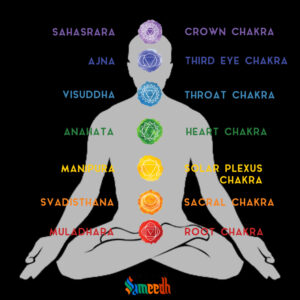The Sahasrar, or crown chakra, is a significant concept in Hinduism and is associated with the spiritual energy system in the human body. In Hindu philosophy, particularly in the context of yoga and the Kundalini tradition, the Sahasrar chakra is considered the seventh and highest energy center.

- Location: Crown of the head
- Color: Violet or white
- Element: Beyond elements, pure consciousness
- Significance: Represents spiritual connection, divine consciousness, and enlightenment.
- Deity: Sahasrara is often associated with Lord Shiv in his formless aspect, representing the ultimate reality.
The Sahasrar chakra is one of the 7 Chakras located at the crown of the head, slightly above the physical head. It is associated with the pineal gland in the brain. The traditional color associated with the Sahasrar chakra is violet or white. These colors symbolize purity, transcendence, and the highest spiritual consciousness.
While other chakras are associated with specific elements like earth, water, fire, air, and ether, the Sahasrara is often linked with the element of consciousness or pure cosmic energy. The Sahasrar chakra is often symbolized as a thousand-petaled lotus. Each petal represents a different aspect of spiritual consciousness, and the fully bloomed lotus signifies the full expression of enlightenment.
The sound, or Sanskrit mantra, associated with the Sahasrar Chakra is “Aum,” pronounced A-u-mn. It is the sound present in the universe, and can only be heard when the mind is completely still.
The Sahasrar chakra is associated with various deities in Hinduism. In some traditions, it is linked to Lord Shiv, who represents the ultimate reality and transcendent consciousness. Other traditions may associate it with different deities or consider it a space where the individual soul connects with the divine. Activation and balancing of the Sahasrar chakra are believed to lead to spiritual awakening and a higher state of consciousness. It is considered the center of divine wisdom, self-realization, and connection with the universal or cosmic consciousness.
When this chakra is balanced and open, it is believed to allow us to experience a sense of unity with the universe and to connect with a higher power. On the other hand, if the sahasrar chakra is blocked or imbalanced, it can lead to a feeling of disconnection and a lack of spiritual fulfillment.
To balance and open the sahasrar chakra, some practices that may be helpful include:
Engaging in activities that promote a sense of spiritual connection, such as meditation, yoga, or prayer
Using essential oils or crystals that are associated with the crown chakra, such as lotus or selenite
Visualizing the color violet or the symbol of the sahasrar chakra to help bring awareness and energy to this chakra.
Practices such as meditation, prayer, and certain yogic techniques are believed to help activate and balance the Sahasrar chakra. These practices aim to quiet the mind, elevate consciousness, and facilitate a connection with the divine.
Balancing the Sahasrar chakra is seen as a vital aspect of achieving a harmonious and enlightened life. It is associated with a sense of purpose, inner peace, and a deep understanding of the interconnectedness of all things.
